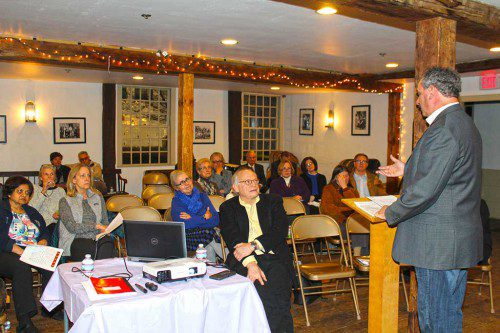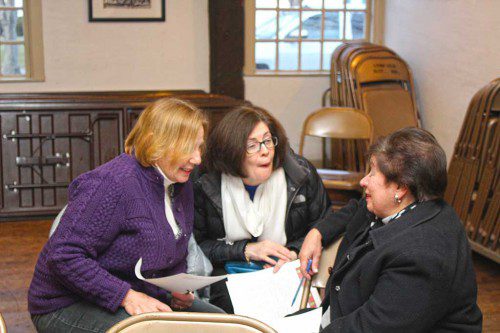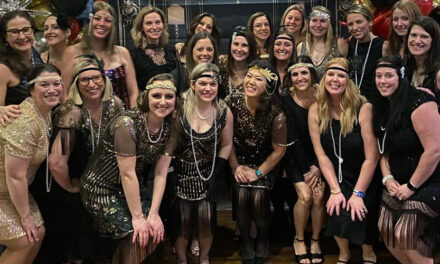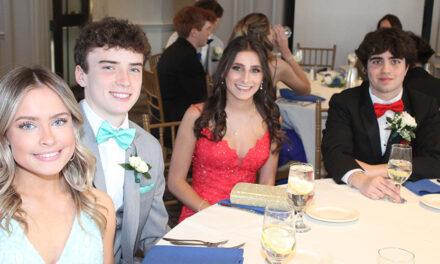Published in the April 5, 2017 edition

THE LIBRARY forum at the Meeting House was like two meetings in one as Ted Caswell, chairman of the Capital Facilities Advisory Committee (CFAC), was invited to provide an update on the status of the ongoing evaluation of all municipal buildings in town. (Maureen Doherty Photo)
By MAUREEN DOHERTY
LYNNFIELD — Numbers played a prominent role in last week’s community forum on the status of the town’s grant application to the Massachusetts Board of Library Commissioners (MBLC).
The 35 people in attendance at the forum learned that this year marks a huge milestone in the history of the Lynnfield Public Library — its 125th anniversary will be celebrated in July. Another milestone will be reached in July — the announcement of the potential awarding of state grants to Lynnfield and over 30 other communities in the queue of the current five-year funding cycle will be made on July 13.
Forum attendees also learned from Library Director Holly Mercer that during Fiscal Year 2016 there were 92,963 visitors to the library at a facility that has just 12 dedicated parking spots (with overflow parking and employee parking located across the street at Town Hall).

SHARING a laugh together prior to the start of last week’s community forum on the status of the library building project were (from left): Ann Decker, Patty Nutile and Maryann Mazzola. (Maureen Doherty Photo)
The library is open 64 hours per week and its reference librarians answered over 11,640 questions from patrons while more than 5,600 people attended an event held at the library in FY16.
The library has 71,000 items in its collections, Mercer said, which does not include e-books and other electronic resources. While physical books remain popular with patrons of all ages, Lynnfield’s library patrons also “borrowed” nearly 5,500 e-books in FY16 and visited its website 26,763 times, she said. The library serves an average of 470 patrons per week who use its public Internet computers and provides over 14,000 wireless session to patrons each year.
Lynnfieldians also read more than the average American, checking out an average of 11 items per year versus the national average of eight, and nearly three-quarters of the town’s 12,500 residents have a library card.
The current building at 18 Summer St., which includes a children’s room that was once a schoolhouse back in the 1850s, is just over 14,000 square feet. It would be repurposed for other town uses currently being identified under the broader Capital Facilities Advisory Committee (CFAC) long-range plan being formulated on all municipal buildings in town. One of the reasons the LBC has requested that this project not be funded for three years if approved in 2017 will be to better align the schedule with the town’s plans for all of its buildings. School debt will also be retired in a few more years as well.
Price tag: $21.1M
Of course, the biggest number of them all was the final cost of a new library building, calculated using construction cost projections for 36 months in the future at $21.1 million. The cost would be bonded over 20 years and paid for at a flat rate per year via a debt exclusion override of Proposition 2 1/2.
With the support of Town Meeting voters last October, a dedicated parcel of the Reedy Meadow site was given to the control of the Board of Library Trustees to enable the town to file its 450-page grant application in January. The new library site would be located one-third of a mile down the road from the current site on an under-utilized portion of the adjacent golf course and would provide space for a 25,874 square foot building with 70 dedicated off-street and fully accessible parking spaces.
It would also incorporate community meeting rooms accessible to all community groups outside of the typical library hours of operation. This was considered an essential part of the plan given the demand for access to such space by groups of all ages, sizes and interests, and the library’s vision of providing a lifelong learning facility that can be embraced by the entire community on a space that provides sweeping and inspirational views utilizing both indoor and outdoor amenities.
Library Building Committee Chairman Russ Boekenkroeger stressed again that no taxpayer funds have been expended to apply for this state grant. It was done through utilizing other grants available for this purpose and funds set aside for this purpose.
Mercer said that architecturally, the building will reflect the town’s “rich heritage.” She said, “The architecture of the Meeting House is planned to tie into the exterior of the new building.”
Viewing a sketch of the schematic plan for the Summer Street elevation, one abutter asked those in attendance if the rendering looked like it tied into this heritage. Another resident, who said she supports the new library, added that while she would favor the expansive glass windows that face Reedy Meadow in the rear of the building, she would really like to see the Summer Street elevation look more like the town’s traditional colonial architecture.
Boekenkroeger explained that it is difficult to see from this schematic rendering that the Summer Street elevation is actually 70 percent clapboard and 30 percent glass but due to the limited funding available to get to this stage of development, the architectural plan is not complete. While the final square footage of the building and various rooms would be “fixed” he stressed that various elements can be “reconfigured” and there would be “plenty of time to synthesize an opinion” with the townspeople on the final design elements if and when the state grant is awarded and the town votes to spend its share of the cost.
The objective of this 21st century library plan seeks to answer the question: “How can we meet needs of the community in the world that we live in today and also build in that flexibility and adaptability we need in the future?” Mercer said.
“We also looked at what’s unique about the town, what’s unique about the site and how are we going to tie that into our project? The site is just incredible,” she said, so they put a lot of thought into “what it would mean to be in a space like that, how the light comes in, how comfortable it is.”
Boekenkroeger said the state application process is quite standardized to enable the MBLC to evaluate “on an even basis” all of the projects submitted. Originally, 35 towns had applied for this round of funding and that number has since dropped to 32.
“It is not an unending amount of money that is available. This current round has $150 million in the bond,” he said, adding that because the process is “so competitive” they wanted to do the best job they could “to get to the top of the list to become funded before the money runs out.”
“It is a huge investment that the state has made” in this bonding process to fund its libraries, he said, explaining that the design must meet the community’s needs for a minimum of 20 years. This caused a bit of laughter in the room given that the forum was being held in a building that was built in 1714.
Although funding could be available as soon as 2018, the LBC has stressed in its application that ideally, the town would want to build it in the year 2020 or 2021. The grant requires that they project out costs for 36 months, therefore the estimated $21.1 million figure for this project is based on 2020-21 dollars, and includes all contingency fees, Boekenkroeger said.
Given the split between the state grant and the town’s share, this means the town would receive an estimated grant reimbursement of $8.1M while the town’s share would be $13M bonded over 20 years at a level rate.
20-year bond
Town Administrator Jim Boudreau explained that this would be done through debt financing with a Prop. 2 1/2 override that would cost approximately $31 per $100,000 of property value. The T.A. added that the town would be putting a debt calculator on its website where each homeowner could plug in their property value and calculate their actual cost per year. An average home would see an increase of about $200 to $250 per year, he said.
The operating expenses of the library would continue to be funded out of the regular operating budget, Boudreau said.
One woman asked if there had been anyone with a lot of wealth who had bestowed any money to the town for its library. Boekenkroeger said that a nonprofit library foundation has been established into which fundraising monies would be channeled as a means of offsetting expenses otherwise borne by the town. Some seed money toward a new library building of $100,000 had also been given to the town by the Tennessee Gas Pipeline many years ago, he said
During the question and answer period, Selectman Dick Dalton asked how long the town would remain on the funding list once the project was approved.
Boekenkroeger said, “Until you ask to come off.”
Once a project is approved by the state, a town must approve its share of the cost within six months. Rep. Brad Jones used the town of Reading as an example of having benefited by being ready to go with its project. Reading had originally been on the list in the last round of funding after the town of Grafton.
When Grafton failed to get its local funding approved, Reading was moved up on the list and was ready to go because its funding had been approved at Town Meeting. Jones said Reading recently completed its new library building. Several years earlier, Jones said the town of Middleton had utilized the state’s Community Preservation Act to raise funds earmarked to preserve and expand its library, which was located in a historic building.
In response to a question from the audience, Jones said the legislature has reauthorized the library bond bill “two or three times” during his tenure and all of the funds come from state taxpayers. There are no federal funds tied into the library bond bill, he said.




